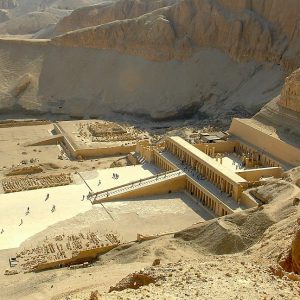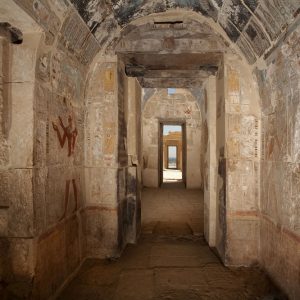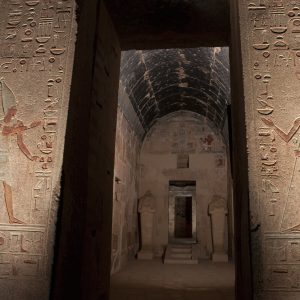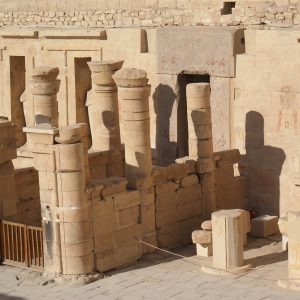Another part of the Temple of Hatshepsut at Deir el-Bahari is available to the public. The opening ceremony of the Main Sanctuary of Amun-Re and the Ptolemaic Portico was held on 9th December.
The Sanctuary of Amun-Re is located in the middle of the west wall of the Upper Courtyard of the Temple of Hatshepsut. It can be entered through the granite through the Ptolemaic Portico and the granite portal, situated exactly on the prolongation of the line of the ramps leading to the Lower and Middle Terrace. The Main Sanctuary consists of the Bark Hall and the Statue Room with three chapels. The first room housed the sacred bark of Amun during the ritual and it is the most magnificent part of the complex. The most important moment of this ritual – placing the bark of the deity, which was brought there every year from the Temple at Karnak on the shoulders of priests, on a pedestal – was depicted on the side walls. There were also niches for statues of the members of the royal family who in this way participated in the cult together with the deity.
The Polish-Egyptian Conservation Mission at the Temple of Hatshepsut at Deir el-Bahari was founded in 1961 by Prof. Kazimierz Michałowski. Since then, archaeologists, restorers and architects associated with the Polish Centre of Mediterranean Archaeology University of Warsaw have been documenting and reconstructing the temple. Since 1999, Dr. Z. E. Szafrański is the director of the Mission. The Main Sanctuary of Amun-Re is one of the best-preserved rooms of the complex. After a hiatus during which they worked in other parts of the temple, archaeologists resumed their activities in the Sanctuary, at first excavating, later restoring, and in recent years documenting it. Since work in the Sanctuary has been completed, it is now open to the public.
The opening ceremony of the Main Sanctuary of Amun-Re and the Ptolemaic Portico preceding took place on 9th December at 14.00. The ceremony was hosted by the Egyptian Ministry of State for Antiquities, represented by the Minister of Antiquities Prof. Khaled el-Enani, and the Polish Centre of Mediterranean Archaeology University of Warsaw, represented by its Director, Prof. Tomasz Waliszewski, with the participation of the Polish Ambassador, H.E. Michał Murkociński, and the Governor of Luxor, Mohamed Badr. The PCMA will be also represented by Dr. Artur Obłuski, Director of the Research Centre in Cairo, and Dr. Zbigniew E. Szafrański, director of the Polish-Egyptian Archaeological and Conservation Mission at the Temple of Hatshepsut at Deir el-Bahari.
Two years ago, on 22nd February 2015, another part of the Temple of Hatshepsut, the Complex of the Sun Cult, was opened to the public.
For more information on the Temple of Hatshepsut at Deir el-Bahari, see the Mission’s website.







